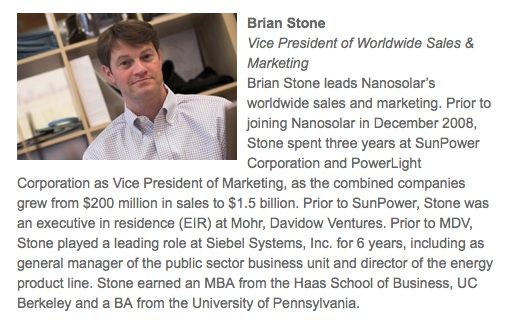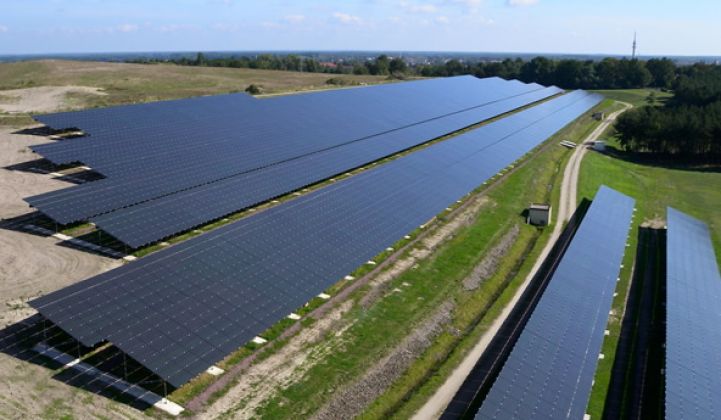Depite still remaining on the company website, Brian Stone, a long-time senior employee of Nanosolar, is no longer with the company. (Credit a commenter on GigaOm for pointing this out.)
Bryce Yang, an employee of Mr. Stone and sales analyst at Nanosolar, verified this information. Michelle Wagner, Director of HR Operations at Nanosolar, has not returned our calls.
We've learned that Stone has joined C3 -- Tom Siebel's Energy Resource Management software company -- to lead Products.
As one of the first wave of capital-intensive, VC-funded, next-generation thin-film solar companies, Nanosolar raised a lot of cash (more than $400 million in private equity) but was prone to over-promising and under-delivering. Faced with an economic slowdown, a precipitous decline in global module pricing, a bit of boardroom carnage that brought in a new CEO (Geoff Tate, formerly of Rambus and AMD) -- the firm stayed relatively quiet in 2010 and regrouped.
Stone survived both the Martin Roscheisen era and the Geoff Tate reorganization, so it is surprising to hear of him leaving the company at this point.

We estimate that the firm produced less than 20 megawatts of its CIGS solar panels in 2011.
Stone and Nanosolar had a history of technical and commercial promises, most recently these relating to cost:
- Below $1.00 per watt factory cost by the end of 2011
- Low $0.80s or high $0.70s per watt by late 2012
- In the $0.60s in 2013
- Below $0.60 per watt in 2014
Nanosolar produced 2.5 megawatts of panels in 2010. The firm has suggested that it will ship megawatts measuring in the "triple digits" in 2012. Cell production capacity was to be 115 megawatts at the end of 2011, and the next step jumps the firm to 250 megawatts of cell capacity at the San Jose facility. Panel assembly is performed at Nanosolar's factory in Luckenwalde, Germany.
The firm is shipping 10 percent efficiency panels today with a target of 12 percent efficiency this year. Expectations are for 13 percent in 2013 and 14 percent in 2014. However, attaining a 4-percentage-point increase in efficiency in the space of four years would be an unprecedented feat never before achieved by any solar firm.
The company is focused solely on utility-scale deployments. Its large utility-size panels are currently rated at 200 watts, with additional output gains expected as efficiency rises.
Nanosolar also announced that it has signed long-term supply agreements for up to one gigawatt of PV panels with Belectric of Kolitzheim, Germany; EDF Energies Nouvelles of Paris, France; and Plain Energy of Munich, Germany.
Take that "long-term supply agreement" lingo with a grain of salt, however. These contracts are not binding, are not take-or-pay, and are predicated on Nanosolar's ability to achieve its cost and efficiency targets as promised. Still, although those agreements don't translate as real backlog, they do translate to patient customers who appear willing to work with Nanosolar. Nanosolar, as a new supplier without a field performance track record, employs module warranty insurance to help financiers and customers feel comfortable and improve the firm's bankability.
Ed Gunther reported on a number of other promises made by the company at a recent solar event.
An investor in Nanosolar I spoke with recently still maintains that Nanosolar is one of the few firms that can give First Solar and the Chinese c-Si vendors a run for their money. From here on in, however, the firm will be doing it without Brian Stone's creative interpretations of reality.
Nanosolar will also have to be raising large amounts of funding in the short term, a difficult situation in the post-Solyndra CIGS era.



